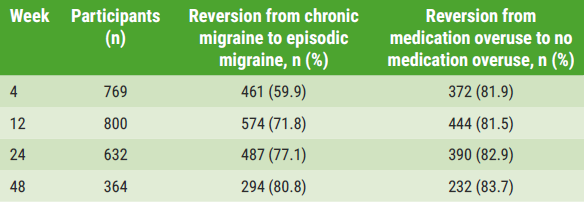https://doi.org/10.55788/8d8ca290
In the acute treatment of migraine, non-oral therapies are recommended for attacks that include severe nausea or vomiting, or rapidly escalating headaches. Zavegepant is the only small-molecule calcitonin gene-related peptide (CGRP) antagonist delivered by nasal spray for the acute treatment of migraine. Dr Robert Croop (Biohaven Pharmaceuticals, USA) presented the results of the double-blind, randomised study (NCT04571060) that assessed the efficacy and safety tolerability of zavegepant nasal spray.
Participants were 18 years or older, with at least a 1-year history of migraine and 2–8 moderate-to-severe migraine attacks during >15 monthly headache days in the 3 months prior to screening. Of the 1,405 randomised participants, 1,269 were evaluated for efficacy (zavegepant n=623; placebo n=646). The mean age was 41 years, 83% were women. The participants self-administered 1 dose of zavegepant 10 mg nasal spray or placebo to treat 1 migraine attack of moderate-or-severe pain intensity. There were 2 primary endpoints: 2-hour freedom from pain and the most bothersome symptom (MBS).
Zavegepant was superior to placebo for 2-hour freedom from pain (23.6% versus 14.9%, p<0.0001) and 2-hour freedom from MBS (39.6% vs 31.1%; P=0.0012). The active treatment was also superior to placebo on multiple secondary endpoints, including:
- pain relief at 15 minutes (15.9% vs 8.0%; P<0.0001);
- pain relief at 2 hours (58.7% vs 49.7%; P=0.0012);
- return to normal function at 30 minutes (10.5% vs 6.1%; P=0.0059);
- return to normal function at 2 hours (35.8% vs 25.6%; P=0.0001);
- sustained pain relief 2 to 48 hours post-dose (36.1% vs 29.6%; P=0.013).
No serious adverse events were observed; most were mild or moderate. The most common adverse events, occurring in ≥2%, were dysgeusia (20.5% vs 4.7%, respectively), nasal discomfort (3.7% vs 0.8%), and nausea (3.2% vs 1.1%).
- Croop R. Efficacy and safety of zavegepant nasal spray for the acute treatment of migraine: Results of a phase 3 double-blind, randomized, placebo-controlled trial. P136a, EHC 2022, 07–10 December, Vienna, Austria.
Copyright ©2022 Medicom Medical Publishers
Posted on
Previous Article
« What to do when conventional treatment of headache fails in children Next Article
Onabotulinumtoxin A effective in older patients with chronic migraine »
« What to do when conventional treatment of headache fails in children Next Article
Onabotulinumtoxin A effective in older patients with chronic migraine »
Table of Contents: EHC 2022
Featured articles
EHF consensus on effective migraine treatment and triptan failure
IHS President: “It is time for operationalisation of ICHD”
Headache Prophylaxis
Intervention
EHF consensus on effective migraine treatment and triptan failure
Sustained long-term effect of occipital nerve stimulation in MICCH
Onabotulinumtoxin A effective in older patients with chronic migraine
What to do when conventional treatment of headache fails in children
Predicting response to medical and surgical treatment of trigeminal neuralgia
Breakthroughs in Understanding Headache
IHS President: “It is time for operationalisation of ICHD”
GWAS identifies 7 loci for cluster headache
Towards precision medicine: salivary CGRP and erenumab response
Persistent headache after stroke: not rare and often overlooked
Additional effects of gepants on top of erenumab
Headache Prevention
Idiopathic intracranial hypertension: key factors influencing visual outcomes
Patients with migraines smoke less, drink less, and use fewer illicit drugs than general population
© 2024 Medicom Medical Publishers. All rights reserved. Terms and Conditions | Privacy Policy



